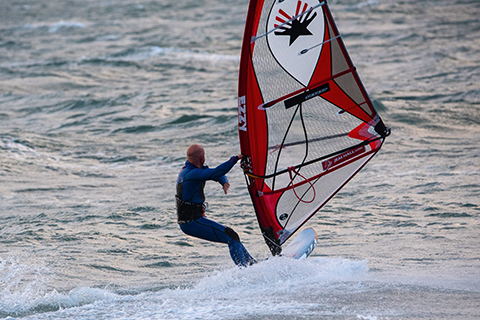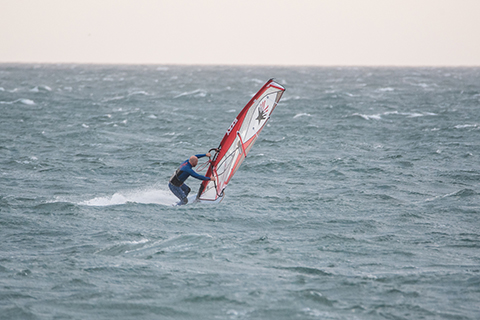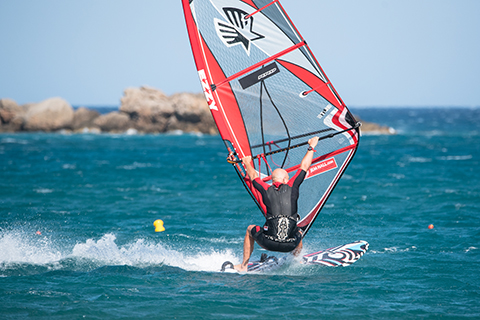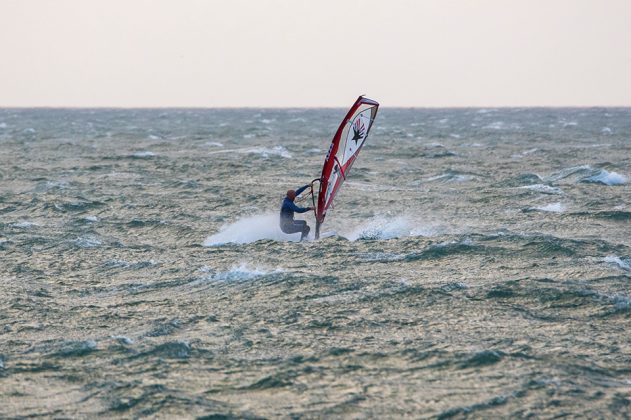JEM HALL
MOVE ON UP – WINDSURFING TECHNIQUE
WINDY GYBING
With the windy season well underway, this month I take a look at how to gybe when it is getting wild out there. You may feel that the gybe is quite a complex move but actually it is just a sequence of key positions that should follow in succession whilst, as ever, employing a clear strategy.
Words Jem Hall // Photos Nicolas Jones
www.jemhall.com
(This feature originally appeared in the January February 2018 issue of Windsurf Magazine. To read more features like this first, Print and Digital subscriptions
are available. Prices include delivery globally for 10 x issues a year!)
It is simple but challenging and when it cuts up rough, is a physical and mental test. A positive self-dialogue alongside a lot of self belief and resilience will see you making way more gybes and especially so when you are fully stacked! You will also be better placed to up your gybe success rate by being cardio fit and physically strong, as when it is windy, sailing in a straight line is more tiring and once you unhook the sail it has a lot more power coming through it and thereby you! When you are gybing fully powered up you really need to be precise and be ready and able to control a lot of power! On my recent Ireland clinic we took on Storm Ophelia, when the wind was somewhat manageable, and I gave my crew some top tips on gybing and some of their responses were along the lines of ‘Yeah, yeah that might work in Rhodes but …’ This made me consider how they went about their business and also look at what really worked for my gybing whilst stacked on a 3.4 and so compile the tips to present in this feature.

Prepare with precision and keep low as you bear away.

Look forward, be low and lean to get you carving out and finishing across the wind faster in your gybe exits.
Ready to do battle
I place a strong emphasis on preparation for all moves and none more so than for gybing. By failing to prepare (with precision and power) you are in effect preparing to fail. I will present the main technique tips for the prep phase of the windy gybe but please also know that you have to believe you will make it and be resilient throughout. Furthermore, you must also spot your ‘opportunity’ to gybe, either spotting a lull or a suitable place to start your arc. This could be a bit of swell, a wave to gybe off or some flat water on the inside with a good amount of space between the chop / waves. Yes it is definitely location, location, location. As you try more gybes in stronger winds you will get better at choosing the areas to gybe in and the timing of these too.

Laying the rig down is an alternative method to drop power when you have more time and space.
Preparation tips:
• Take an upwind line to settle the board and decrease sail power.
• Pull down hard on your front hand in order to keep the board down as you slide the back hand way way back.
• Drop deep in your harness lines to keep settled and tighten the line for an easier unhook.
• Unhook by bending your arms in (not by raising your hips) and keep down James Brown.
• You are now ready to get your back foot out and place it right next to the back footstrap.
• As you have slowed down, when you scissor the board to head downwind the sail power will decrease as you increase in speed off the wind but this is only briefly!
• And yes you scissor the board to head downwind by pushing through the front leg and pulling in with the back leg.
• You are now ready to attack the gybe and with the 2 options of either a more laydown (front foot) gybe or a layback gybe (more off the back foot).
Layback vs. Laydown
You have set up well for your gybe and prepared precisely whilst spotting your gybe zone and now you have two options of gybe style to get round this corner whilst dealing with all this power.
Lay it down & forward
If you have a bit of a space and are powered up, but not hammered, then you can do more of a laydown style gybe. Please note this is not laying the sail back down in the water but more of a drive forward with some solid sheeting in to depower the sail and enables you to drive forward and carve off the front foot. This requires more space and time and we will not be covering this at length here but a few tips are to:
• Roll forward across the rail and really bend your front ankle and knee as you go into it – attack and commit.
• Look forward and see the water in front of you.
• Aim for a short positive sheet in with the backhand and do not dwell there too long.
• When done right the sail should be light and this means that you will have to actively bring it back up and open it as you go into your “Fire Exit”, covered later in this piece.
Layback & keep it up
This gybe is more off the back foot with the sail remaining more upright. You rely upon the sail twisting, alongside a super low position, as you carve more off the back foot through a tighter arc. The sail is sheeted in hard but the rig is kept upright on an extended front arm. It is a great gybe when fully powered as this quick sheet in can dump a lot of power quickly and it forces you to stay low, plus you will also pick up less speed. In effect all these actions will get you round the corner faster so it is all over and done with quicker, which is a huge benefit whilst the sail is trying to pull your arms out of your sockets!
Try to visualise here the powerful mantras of rig forward (and up), body back, or in another way ‘Bend and extend,’ i.e. bend your back leg a lot and extend your front arm. These actions keep the board flat and allow you to carve even whilst dealing with all this sail power that is trying to make the board levitate.

When it cuts up rough it is time to commit, get low, exaggerate and layback gybe.

Even when very windy you may still have to take some power clew first to finish your gybes.

It is not over yet! Plane from the straps before hooking in to get anchored to the board.
Top Tips & Key Positions:
• Follow the preparation phase to the letter.
• Ensure the back foot is right next to the back strap on the rail.
• Scissor downwind and then roll into the carve, all whilst pulling down hard on the front arm – attack and commit.
• As in all carves you will initiate the carve on the front foot, on an extended front arm, but you will quickly transition to carving off the back foot.
• Roll in, feel the rail engage yet keep the rig upright and really sheet in with the backhand. This dumps a huge amount of power as the rig twists off and momentarily stalls enabling you to look out of the turn and carve off the back foot.
• Really exaggerate throwing your hips to the inside of the turn to carve hard off the back foot through a very very bent back leg and ankle.
• Look out of the turn and open the sail fast as you go into your foot change and ‘Fire Exit’.
Fire Exit
You have a few very simple targets here; get out of this turn fast, get the board back across the wind and stay super low. Essentially you are looking to get out quick and safe. I strongly recommend a more comprehensive recap on the ‘Gybe Exit’ so please revisit the ‘End Game’ feature on www.windsurf.co.uk/jem-hall-move-on-up-end-game from the Nov/Dec 2015 Magazine.
To Fire Out Of Your Exit:
• Look out of the turn and look forward throughout the rig rotation.
• Get low and outboard to enable you to carve off your heels after changing your feet. Think and repeat ‘look and lean.’
• Keep the rig away, which will give you space and leverage to carve it out by being down James Brown and looking forward to see your exit.
• Ensure your foot change gets the new back foot heel onto the rail so it can carve the board round fast.
• Have a slick boom-to-boom rig change with ‘NO Gear Gazing’, as you ‘Look Forward’ and see your exit line.
• Move the rig through a big circle by sending the rig back; this helps to turn the board. Then really drive it forwards after you collect it with an overhand grip.
• Finish the gybe super low, slightly upwind on extended arms (extend and bend!) and then get in the straps before hooking in.
• Pull down hard on the boom to help getting in the straps, resist the
temptation to sheet in, as there is just too much power there to deal with.
• You may well have to do a bit of clew first wrestling so ensure you have this skill in place and yes pull down on the clew hand to flatten the board and allow your mast hand to slide more easily.
Focus on the phases, believe in yourself and know that you shall, will and can deal with all this power as you get round those corners and enjoy all the carnage that strong wind sailing gives us. Lastly, this layback gybe technique can also really help the skills required for back foot waveriding when overpowered. How we gybe is how we ride.
Kit
Generous sized straps and positioned a good distance apart in relation to your leg length to give you a wide stable base to gybe off.
Slightly tighter straps give you a bit more control when it is really windy and you are rattling around more. Long lines enable you to both unhook and hook in from a low position and with ease. Tight harness and hook makes unhooking more efficient as the line will drop out easier! Relatively low boom to get you low and thereby keep the board in the water.
“ Really sheet in with the backhand. This dumps a huge amount of power as the rig twists off. ”
RRD boards, wetsuits, softwear, Ezzy sails & Black Project Fins sponsor Jem Hall. Get him live and direct on one of his highly acclaimed coaching holidays but be quick as they are selling out – check out his website www.jemhall.com for details. You can also follow him on twitter / Facebook/Instagram.


